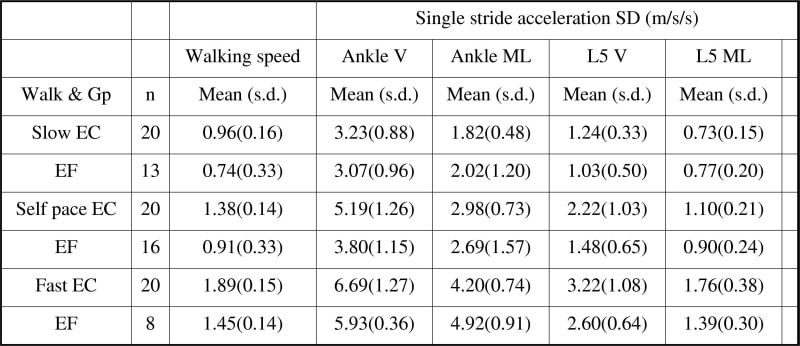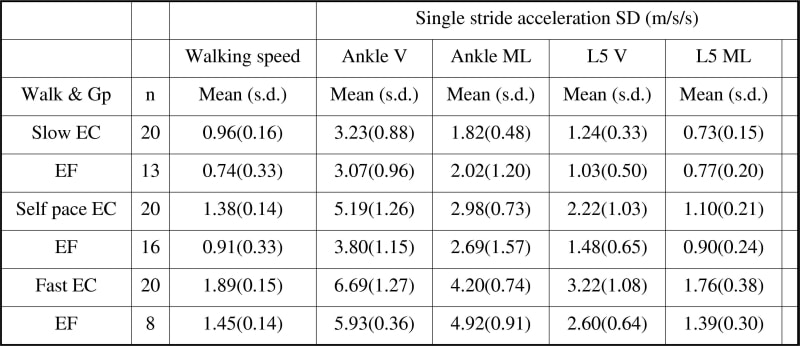Assessment of gait and postural stability is often qualitative; gait laboratory access is rare (Toro, Nester, & Farren 2003). Common quantitative measures (standing sway and spatiotemporal walking parameters) have limited relevance to postural stability during activity (Moe-Nilssen 1998a); accelerometers have been suggested for this purpose (Moe-Nilssen 1998b). This preliminary study investigated walking stability in older people using accelerometry (King’s College REC approved). Eight subjects were assessed; four healthy older adults (aged 71±4yrs, BMI 24.7±1.2) and four with a history of either a fall or a trip (aged 71±4.5yrs, BMI 29.6±6.1). Accelerometers recorded vertical and mediolateral (ML) acceleration at the ankle and L5 (near the centre of mass, COM) during self-selected ‘slow’, ‘comfortable’ and ‘fast’ walking wearing shoes. Postural stability was quantified using standard deviation (S.D.) of acceleration (normalised for walking speed) for each of 5 strides per condition. Results were analysed using SPSS and MathCad. ANOVA tests were used for between group comparisons. Significance was set at P<0.05. Average walking speed was significantly slower for the fallers (mean±S.D.) 0.84±0.37 m/s compared to control older subjects 1.41±0.41 m/s. Walking speed and gait cycle segment acceleration SD's are presented in Table 1. After normalising for walking speed, vertical and ML acceleration SD's at the ankle were significantly higher for the fallers for all walking types. Vertical spinal acceleration SD's were only significantly increased for the fallers during slow walking. ML spinal measures were significantly increased for the fallers for slow and comfortable speed walking trials. Nine out of twenty-four measures of acceleration recorded at either the ankle or near the COM were able to significantly distinguish fallers or subjects who had experienced a trip from age matched non-fallers. The increased deviation of gait cycle acceleration near the COM during walking in the group of fallers indicate poor dynamic postural stability while measures at the ankle may also reflect unsteadiness in intended movement. Accelerometers appear to allow sensitive, inexpensive and portable analysis of dynamic postural stability in elderly people.
King's College London (2005) J Physiol 565P, C28
Communications: Measurement of postural stability during walking
Cook, K ; Smith, ICHS ; Newham, DJ ;
1. Centre for Applied Biomedical Science Research, King's College London, London, United Kingdom.
View other abstracts by:
Table 1. Walking speed and SD (within stride standard deviation) and s.d (deviation between strides/subjects) of ankle and spinal (L5) vertical (V) and ML acceleration over one gait cycle during slow self pace and fast walking completed by 4 elderly control subjects (EC) and 4 elderly fallers (EF). n denotes total number of gait cycles analysed per group.
Table 1. Walking speed and SD (within stride standard deviation) and s.d (deviation between strides/subjects) of ankle and spinal (L5) vertical (V) and ML acceleration over one gait cycle during slow self pace and fast walking completed by 4 elderly control subjects (EC) and 4 elderly fallers (EF). n denotes total number of gait cycles analysed per group.
Where applicable, experiments conform with Society ethical requirements.


